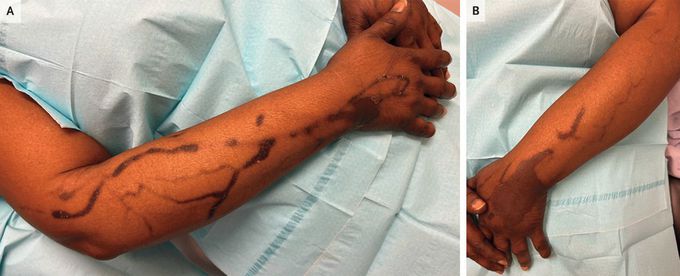


Serpentine Supravenous Hyperpigmentation
A 58-year-old woman with a history of metastatic uterine leiomyosarcoma presented to the dermatology clinic with a 1-month history of a nonpruritic rash on her arms. Six weeks before presentation, she had started palliative chemotherapy with gemcitabine and docetaxel, which had been administered through peripheral intravenous catheters. On examination, hyperpigmented plaques were observed on the dorsa of both hands at the sites of previous intravenous access. The darkened skin extended up the arms in a linear pattern along the network of superficial veins (Panels A and B). The skin lesions were slightly palpable but were not tender. A diagnosis of docetaxel-associated serpentine supravenous hyperpigmentation was made. Serpentine supravenous hyperpigmentation is a cutaneous side effect of several intravenous chemotherapy agents, including docetaxel, vinorelbine, and — most commonly — fluorouracil. The mechanism of skin hyperpigmentation remains unclear, but the reaction is benign; the underlying veins remain patent. The reaction can be avoided with the use of a central venous catheter for drug infusion. In this patient, a central venous catheter was placed for subsequent administration of chemotherapy. At a follow-up visit 2 months later, the rash had abated.

